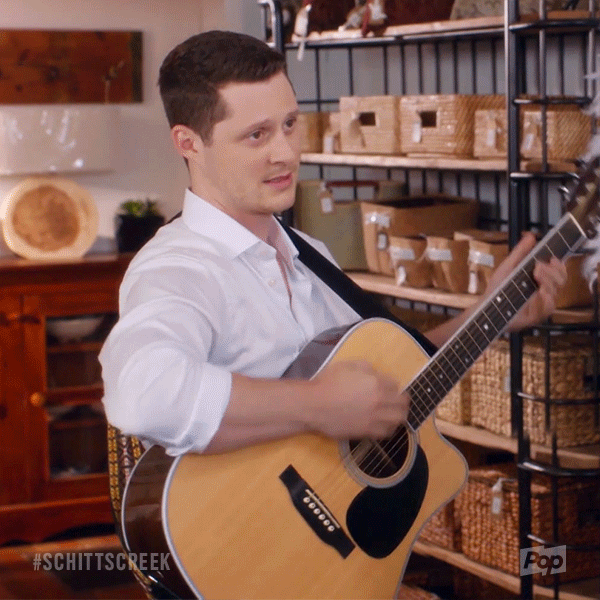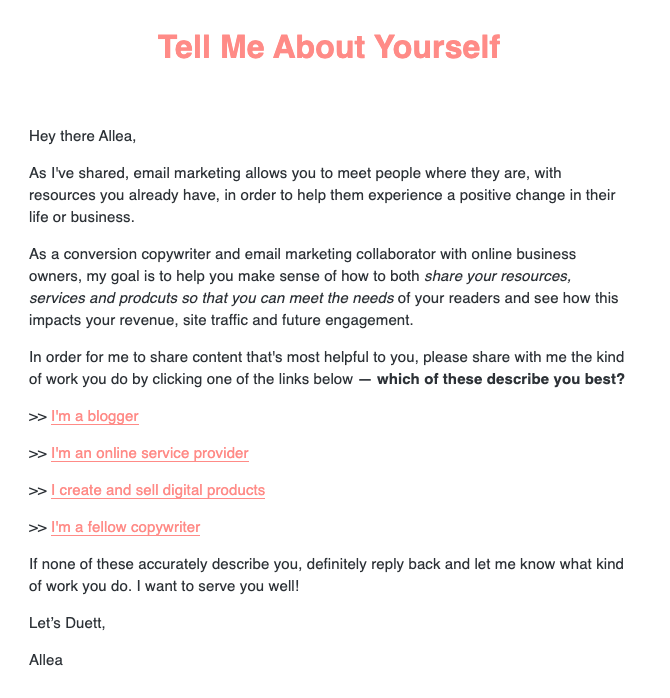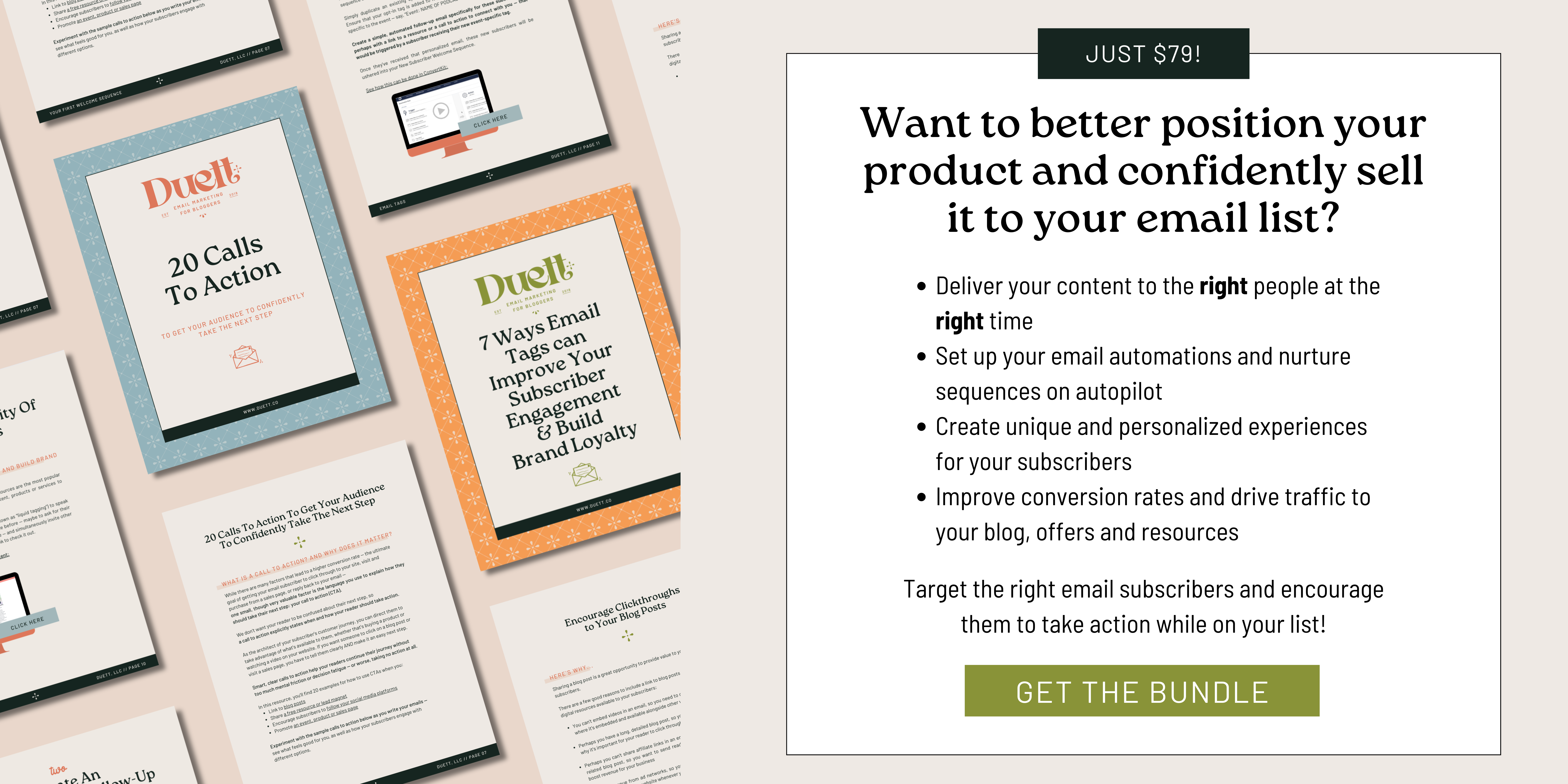Oh hey there, I′m glad you're here!
Join the Email list!
And if you're on the hunt for some top-notch email marketing strategy and conversion copywriting tips - you've come to the right place!
Hi, I'm Allea!
Maybe you’ve heard of “segmenting” your email list and if you’re not sure how that works, you might have tuned it out. Or if you’re like a good portion of online business owners, you start thinking of literally anything else.

Who wants to tackle segmenting your email list, anyway?
But I promise it’s way more exciting than you think, especially when you consider all the benefits it has for your audience. (And we like to keep our readers happy, right? Right!)
Audience segmentation boosts email engagement
Segmentation allows us to share content with the email subscribers it matters to most — and not with those who wouldn’t benefit.
Not every small segment of your audience needs its own automation. But email gives us an enormous amount of flexibility to connect deeper with your reader by sending them only the content they love.
Now, let’s get practical about email segmentation…
An example I often refer to is that of an online business owner — we’ll call him Travis — who teaches how to play guitar through online courses.

How can segmentation help Travis provide value to his readers? He would start by breaking down the process into two steps:
-
Start by assessing the different needs or interests of the audience
-
Then tailoring the messaging to speak directly to that segment of readers
But how?
How to segment your email subscribers
Before Travis can segment his readers, we need learn about his audience from a high level — but also the specifics and trends based on what they’re looking for (and therefore the solutions we can offer to each person on their individual journey).
If you’re not 100% sure what your subscribers need or don’t need, begin by asking questions. I recommend you make no assumptions, unless you have extensive experience with your audience (or even if you do).
Resource: Boost email subscriber engagement and increase conversions by using tags
1 | Learn about your email subscribers
-
Ask subscribers to complete a survey in your welcome automation
-
Track how they entered your email list (by the particular opt-ins or themes they’re engaging with)
-
Ask where they are on a particular journey and use link clicks to see which option they selected
In Travis’s case, he has prospective students coming to his site ranging from novices who just purchased their first Takamine guitar to advanced learners looking to develop specific playing methods.
It’s easy to see that these two audiences have different needs.
In the case of a Duett client, Pinch of Yum, we actually segmented their list based on their skill or confidence level with home cooking (more on that below!).
Related: How to Use Audience Research to Fuel an Effective Email Marketing Strategy
2 | Identify the different needs of your email audience segments
Your advanced players do not need information on how to maintain their guitar for prime sound quality.
But ask yourself, “Why are they coming to my site? What do they want to learn, experience or purchase?”
Listen to their needs to connect with how you can best serve them.
And your novice players would be overwhelmed by the idea of power riffs (“I’m still trying to successfully play the F chord here…”).
In their case, what are THEY coming to your site to learn, experience or purchase? Are they coming for inspiration, accountability or tutorial videos?
This becomes especially helpful (like, so much easier) when you ask yourself these 2 questions while sitting down to write your emails.
In order to serve your audience well, we need to see them more than a mass of names and emails on a list. Segmentation allows us to provide what each reader needs — and avoid sending them what they don’t — as you share helpful content with them now and into the future.
Related: How to personalize email content using subscriber tags in Kit
Learn about your audience to segment and serve them better
How might you segment your audience to better serve them with future emails?
Consider all of the variables that could impact what you may or may not send a segment of readers — or what message you may tailor to them, based on previous engagement with your site, brand or products.
Think about…
-
Their role at work. Are they in a supporting role, or are they a leader who needs a different set of resources?
-
Their responsibilities at home. Are they responsible for managing the finances and you want to make it easier to talk about money with their spouse?
-
Have they purchased something from you before? Use this information to send more, related items for purchase to their inbox.
-
Are they a good fit to join your membership? Or are they a lapsed member who you’d like to re-register? A campaign to these two segments may be better written as two different conversations, right?
-
What’s their employment status? Do they work for a small business, a corporation or are they self-employed? What about their employment status impacts how you can help them?
-
How much debt do they have (+/- $10,000, $100,000, etc)? What kind of debt do they have (student loans, consumer, private loans)? The way you suggest payoff strategies may different based on any number of variables.
There are so many ways to customize your messaging to your audience based on their needs, their lifestyle, and their engagement with your brand!
Resource: Boost email subscriber engagement and increase conversions by using tags
Basically you: “Hey audience, tell me what you want, what you really really want.”

How to implement a self-segmentation email to segment subscribers
You can segment your list through an email that asks your subscribers to click on what most applies to them. In away, we ask subscribers to “choose their next step.”
Here’s an automated email that I used to have in my Welcome Sequence for new Duett subscribers. You’ll see where I give them links to click and “tell” me more about themselves:

For More, Read This: How to segment new email subscribers in your welcome sequence
A blogger segmentation example in action
I want to share an example of how I helped a client segment and serve their list based on what their audience needed most.
When Pinch of Yum approached me about helping with their email marketing, they were struggling with a few things:
- Their email marketing was stagnant
- They wanted a refresh of the content they shared with their list
- And they knew there was more potential in email marketing that they hadn’t tapped into yet
Through audience research and surveying their email subscribers, we learned that there are two audiences of email subscribers who join their list:
- Beginner home cooks
- Those who’ve been cooking a while, but they just need some inspiration
Since one of their big brand goals is to help blog readers to feel confident in the kitchen meant, this presented an opportunity to help out beginner home cooks (before they got intimidated and gave up!).
So by segmenting his their email subscribers based on skill level with home cooking, we were able to serve the Pinch of Yum email subscribers better based on their phase of either being a brand new home cook, having some skills, or being advanced.
Now, if you join the Pinch of Yum welcome sequence, we ask readers to click on one of three answers to this question: Which of these do you think applies best to you?
- I’m new to cooking
- I’m familiar with cooking
- I’m an expert at cooking

Anyone who clicks on the “I’m new to cooking” link gets a special tag, and therefore goes into a New to Cooking series made up of 5 emails that teach basic cooking skills (like how to cut up garlic), shares tools they should buy first (like knives), some foolproof recipes, and overall really ramps up the excitement behind helping them try something new!
Everyone else, subscribers without that tag, is sent directly into the General Nurture Sequence.
The automation for this looks like this:

So what were the results of sending personalized content to these beginner home cooks?
- The “New to Cooking” segment garners an open rate of nearly 62% on average, with a nearly 20% click rate (For context, a “good” open rate is between 20-26%, and a good click rate is 2-3%)
- The “General Nurture” sequence — which the “New to Cooking” subscribers go through, once they’re done with their special sequence — gets an open rate of nearly 45% and a click rate of nearly 7.
- That’s an open rate difference of nearly 20%, and 12% different in click rate. All because of personalization!
By personalizing content for different segments of your audience, you’re able to speak directly to the needs of each subscriber it’s suitable for.
So because beginner readers KNEW the content was for THEM, they were more eager to engage with new emails, knowing it would be what they needed. And secondly, the content itself is what they wanted, so they’re more likely to resonate with the message/content in the emails and click through to learn more, save recipes, etc.
How can you segment your email list?
Spend two minutes brainstorming how different segments of your audience might benefit from receiving messaging specific to their needs. You could think about creating and sending a survey to your list to better learn what your audience needs!
If you’re not sure exactly how you’d like to segment your list yet, the goal is to start listening and learning.
And, if you would like my help creating a Welcome Sequence that segments your audience and provides personalized content based on their needs, book a free Discovery Call and we’ll chat!

More like this!:
November 21, 2019
And if you're on the hunt for some top-notch email marketing strategy and conversion copywriting tips - you've come to the right place!
Hi, I'm Allea!
Join the Email list!
If you’re not welcoming new subscribers and pointing them in the direction of your best, most beloved content — or you feel like the one you have isn’t doing the trick — it’s time we fix that. Use this free 5-part framework to make a meaningful & lasting first impression as you write your first welcome sequence for new email subscribers!
Is Your Welcome Sequence Making a Lasting First Impression?
FYI : I sometimes talk about and link to tools, sites, books, and resources that I LOVE. Sometimes those companies give me a little gift for sharing if you choose to purchase something through my affiliate link. I promise to be straightforward with you and to only share things I personally use and would vouch for 100%.
RSVP NOW!
Join us for the next email marketing roundtable, a free live event where we'll clear up any confusion you have around email marketing — so you can get your message in front of your audience, engage subscribers, and optimize conversions for sales and site traffic.
Learn How to Get Your Email Marketing Working Again
Copyright © 2023 Duett, LLC | T&C | Privacy Policy
Brand & Web Design by K Made
Copywriting by Bushel and Bunch
Photography by Rebecca Marie
We’re Duett, an email marketing agency specializing in email strategy, email copywriting, and email automation setup with a special place in our heart for bloggers (especially those who make delicious food). If you’re a content creator craving to authentically connect with your audience so you can build lasting relationships, increase site traffic, and put your best offers forward — Let’s Duett!